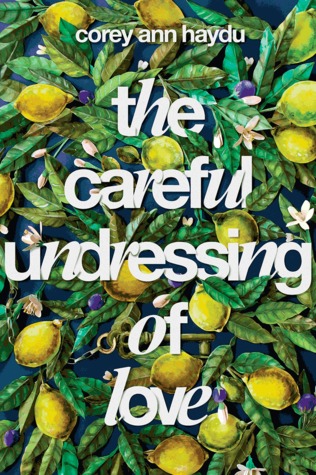Review:
 Title: The Careful Undressing of Love | Goodreads
Title: The Careful Undressing of Love | Goodreads
Author: Corey Ann Haydu
Publication: January 31st 2017 by Dutton Books for Young Readers
Format: Hardcover
Source: Barnes and Noble
Genre: YA; magical realism
Date read: June 2017
Where to Buy: Barnes and Noble | Book Depository | Amazon
Everyone who really knows Brooklyn knows Devonairre Street girls are different. They’re the ones you shouldn’t fall in love with. The ones with the curse. The ones who can get you killed.
Lorna Ryder is a Devonairre Street girl, and for years, paying lip service to the curse has been the small price of living in a neighborhood full of memories of her father, one of the thousands killed five years earlier in the 2001 Times Square Bombing. Then her best friend’s boyfriend is killed, and suddenly a city paralyzed by dread of another terrorist attack is obsessed with Devonairre Street and the price of falling in love.
Set in an America where recent history has followed a different path.
Thoughts:
The Careful Undressing of Love was released in January of this year (2017) with what I would say was…medium buzz. I was semi familiar with the authors work (although I had read none of her other novels) but was curious because this novel seemed to break away from her previous style. The cover of The Careful Undressing of Love is beautiful (as you can see) so that remained a marker in my mind which was GREAT because when I made a Barnes and Noble order in the spring and this came up as a suggested novel. I have to admit–this was purely a curiosity buy!
This is a little unconventional when compared with my other reviews, but I wanted to start with the most notable part of the opening of The Careful Undressing of Love– its epigraph. An excerpt of the second stanza from Carol Ann Duffy’s 1993 poem “Valentine” it reads as follows…
I give you an onion.
It is a moon wrapped in brown paper.
It promises light
like the careful undressing of love.
Okay first we have to acknowledge how amazing this little stanza is…I mean it’s a perfect epigraph. I find it to be particularly fitting for this novel because it references the complicated layers of love and life–which frames this novel perfectly.
Ephigraph amazingness aside, the beginning of The Careful Undressing of Love can come across to a reader as potetially confusing. Though it might not seem it at first (for those who haven’t read the blurb) The Careful Undressing of Love follows a sort of alternate history following 9/11. Everyone in real life (particularly in the United States) has distinct memories of 9/11–or at least some sort of story about where their parents were on that day etc. Whether we like to admit it or not the affects of the Times Square Bombing is ingrained into the culture of the United States and the ramifications of the attacks are still affecting our country today. Thus, the opening of The Careful Undressing of Love comes with a bit of a culture shock because Haydu very seamlessly moves between realistic familiarity and the alternate timeline of her version of history.
One of the things I found most difficult about reading The Careful Undressing of Love is that as the reader you have to balance between the dichotomy of the alternate historical timeline/how that affects the US in the novel and the culture of Devonairre Street. It takes time for Haydu to differentiate between the two which creates a period of confusion for the reader because both come across as strange. As I continued to read it became more clear to me that the lines between this alternate American culture and Devonairre Street culture were purposefully blurry. The best way to consider the overlap is that Devonairre Street culture reflects that of the outside world but takes those ideas to an extreme. Thus, if US culture emphasizes learning about the Affected (those who were affected by the attacks of 9/11) then the Devonairre Street people will focus almost entirely on the past.
Lorna, the protagonist, goes through incredible growth throughout The Careful Undressing of Love and although her life is unlike those of other contemporary teenagers, her experiences are allegorical. At the beginning of the novel Lorna and her friends pick and choose what to believe from their culture (similar to the way that some modern teenagers approach religion). Rather than sticking to the strictness followed by their parents and neighbors, the girls ignore certain rules. What I found incredibly powerful about The Careful Undressing of Love was the different ways in which she and her friends reacted to the “affirmation” of the curse/their culture. Despite the “proof” Lorna grows more and more skeptical of the Devonairre Street culture and with that pushes back against it. Rebellion is a commonality during the teenage experience, and while it is in no way required Haydu cleverly allows her character to become more relatable in a fantastical world. Some of Lorna’s friends do the opposite, and in the face of “proof” fall back even further into the traditions spouted by Lorna’s neighbors and other adult figures. This dichotomy in teenage experiences as demonstrated here is incredibly important because it transfers over in so many ways to contemporary teenage experiences. Almost everyone I know has gone through the experience of a splitting friend group (particularly after the transition into high school) when certain friends buy heavily into a partying culture and other friends don’t.
Due to the culture of Devonairre street and the nature of the curse love is repeated vilified by various characters throughout the novel which in turn causes Lorna’s relationship with Owen to seem ridiculous. Removed from the culture of the novel however, many teenagers date for the experience of dating, whether or not “love is involved”. In that respect, Lorna and Own’s relationship is exactly what it should be–practice. Instead, in The Careful Undressing of Love, the emotions present (and in some cases lack of them) are amplified far larger than any party involved truly feels. In reality, the vilifying of love (or the insistence of its goodness) works out for no one in the end…I’m not sure what to entirely take of from this conclusion but I find it important to note.
The further down in my review notes I look the more question marks I find…alluding to the fact that the novel gets more and more confusing and strange as we go along. For one thing, the cast of characters may have “diverse” descriptors but their identities were overshadowed by the largeness of their culture. I kept forgetting that some characters weren’t white…and was inconclusive about the races of others because Haydu didn’t emphasize that in the novel. In another respect, the sexuality of a character and another character’s suicide’s were used almost for a “shock” factor towards the end of the novel. The lives of the characters are spiraling but I wish that there had been constructive use of their struggles instead of these cop-out *gasp* moments.
The epilogue was completly underwhelming. The real problems of the novel (the big ones) weren’t fixed or answered by the final events of the novel. I was left with lingering questions of “what happens next” because of the abruptness of the ending–but also because I didn’t know my characters very well outside of their culture. When do the Devonairre Street kids do homework? Do they have extracurricular activities? What do they do all the time??? I have the prediction that I perhaps wouldn’t have minded the abrupt ending so much if I had a good idea as to where the characters were headed–that was not the case with The Careful Undressing of Love.
Final Thoughts:
The Careful Undressing of Love is one of those novels that leaves you reeling. Reading it once through didn’t feel like enough–I felt like I’d missed something in my first reading (and I’m a pretty detailed oriented reader)! My lingering questions are a sign of the power of Haydu’s writing…or perhaps the flaws in it. Honestly, I’m not sure one way or another. The experience reminds quite a bit of my experience several summers ago reading Magonia and how in my review I wrote that I felt like I “[hadn’t] even read the book”. I have yet to re-read Magonia (although rereading my review makes me want to!) but I have a feeling that The Careful Undressing of Love will join this list of “to be re-read”.
Literary achievements aside, the “magical” aspects and full fledged bizarre world may make this novel slightly confusing but also worthwhile. I find it incredibly pleasing to read works of fiction that challenge the way I think and the way I read–this novel is one of them. I encourage you to give it a try, I have full faith that your experience could be insanely different than my own. If you need just one motivation to pick this one up–Haydu’s simple and lovely writing, set in a fantastical Brooklyn.
Other Opinions:
Megan | Reading Books Like A Boss
xoxo





